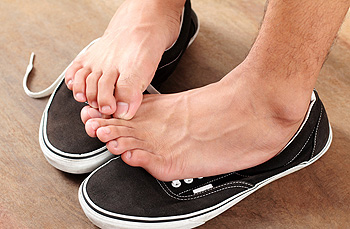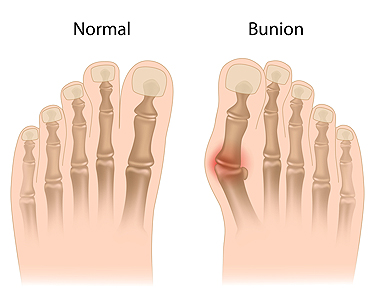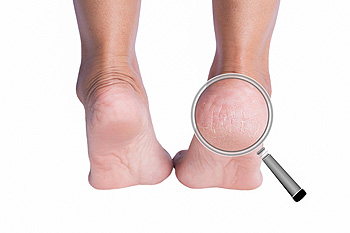Items filtered by date: March 2021
Why Is Podiatry So Important for Older Adults?
 Foot pain is difficult for anyone to deal with, particularly for elderly patients who may already be experiencing challenges with mobility. There are many factors that cause immobility in older adults such as physiological changes, gait issues, arthritis, obesity, diabetes, impaired balance and more. Geriatric foot pain and a reduction in mobility can take its toll not only physically, but mentally and socially as well. Mobility problems can have a ripple effect on an older person’s life—leading to cognitive decline, depression, falls, hospitalization, substance abuse, even incontinence and urinary tract infections. If you or someone you care about has chronic foot pain or difficulty walking or climbing stairs, contact a podiatrist who can evaluate the situation and develop a treatment plan to help reduce pain, increase mobility, and improve the quality of life.
Foot pain is difficult for anyone to deal with, particularly for elderly patients who may already be experiencing challenges with mobility. There are many factors that cause immobility in older adults such as physiological changes, gait issues, arthritis, obesity, diabetes, impaired balance and more. Geriatric foot pain and a reduction in mobility can take its toll not only physically, but mentally and socially as well. Mobility problems can have a ripple effect on an older person’s life—leading to cognitive decline, depression, falls, hospitalization, substance abuse, even incontinence and urinary tract infections. If you or someone you care about has chronic foot pain or difficulty walking or climbing stairs, contact a podiatrist who can evaluate the situation and develop a treatment plan to help reduce pain, increase mobility, and improve the quality of life.
If you need your feet checked, contact one of our podiatrists of Advanced Ankle & Foot Surgeons. Our doctors will attend to all of your foot and ankle needs and provide you with quality treatment.
Geriatrics and Podiatry
When people age, some common issues that may occur are bone density loss, dry skin, poor circulation, and rough brittle nails. These issues may also affect your foot health if the necessary steps are not taken to alleviate the problems.
It is important to take care of your feet because feet that are injured or diseased can affect your overall health. Having painful feet hinders your ability to do daily activities or may decrease your willingness to do the things that you need to do.
Visiting Your Geriatrician
As we age, health problems become more likely, so it is essential to visit your doctor for check-ups to ensure that you are doing the best you can to take care of your health. It is recommended to check your feet frequently for any possible cuts, bruises, swelling, corns or any other irregularities.
Taking Care of Elderly Feet
Cracked or dry feet can be treated by applying moisturizer often. It is also important not to wear old socks because the older the sock is, the higher the possibility there will be that there is bacteria there. Wear fresh socks and make sure they fit properly.
Proper foot health means that you can have a more active lifestyle and you will not be bogged down by pain. Foot health also leads to good circulation, which is paramount for overall health.
If you have any questions, please feel free to contact our office located in O'Fallon, and New Baden, IL . We offer the newest diagnostic tools and technology to treat your foot and ankle needs.
What Should I Do for My Sweaty Feet?
 Excessive and uncontrollable sweating can be embarrassing and uncomfortable. This is known as hyperhidrosis and can often affect the feet. Hyperhidrosis usually occurs when the sweat glands are activated longer than they should be, and issues such as soggy footwear, athletes foot, fungal nail infections and constantly cold feet can occur. Patients who are struggling with overly sweaty feet should consult with a podiatrist in order to find a proper treatment method. Treatment options that may be suggested for hyperhidrosis include prescriptions, surgery to remove sweat glands, or iontophoresis which involves the use of electrical currents.
Excessive and uncontrollable sweating can be embarrassing and uncomfortable. This is known as hyperhidrosis and can often affect the feet. Hyperhidrosis usually occurs when the sweat glands are activated longer than they should be, and issues such as soggy footwear, athletes foot, fungal nail infections and constantly cold feet can occur. Patients who are struggling with overly sweaty feet should consult with a podiatrist in order to find a proper treatment method. Treatment options that may be suggested for hyperhidrosis include prescriptions, surgery to remove sweat glands, or iontophoresis which involves the use of electrical currents.
If you are suffering from hyperhidrosis contact one of our podiatrists of Advanced Ankle & Foot Surgeons. Our doctors can provide the care you need to attend to all of your foot and ankle needs.
Hyperhidrosis of the Feet
Hyperhidrosis is a rare disorder that can cause people to have excessive sweating of their feet. This can usually occur all on its own without rigorous activity involved. People who suffer from hyperhidrosis may also experience sweaty palms.
Although it is said that sweating is a healthy process meant to cool down the body temperature and to maintain a proper internal temperature, hyperhidrosis may prove to be a huge hindrance on a person’s everyday life.
Plantar hyperhidrosis is considered to be the main form of hyperhidrosis. Secondary hyperhidrosis can refer to sweating that occurs in areas other than the feet or hands and armpits. Often this may be a sign of it being related to another medical condition such as menopause, hyperthyroidism and even Parkinson’s disease.
In order to alleviate this condition, it is important to see your doctor so that they may prescribe the necessary medications so that you can begin to live a normal life again. If this is left untreated, it is said that it will persist throughout an individual’s life.
A last resort approach would be surgery, but it is best to speak with your doctor to find out what may be the best treatment for you.
If you have any questions please feel free to contact our office located in O'Fallon, and New Baden, IL . We offer the newest diagnostic and treatment technologies for all your foot and ankle needs.
Reminder: When Was the Last Time...?
How Podiatrists Treat Bunions
 Bunions form when the joint of the big toe gets pulled out of line resulting in the big toe being turned towards the rest of the toes. They appear as a bony lump at the main joint of the big toe, and they can cause inflammation, pain, and corns/calluses. Patients who notice the signs of a bunion should visit a podiatrist for treatment and relief. A podiatrist will usually start with nonsurgical treatments. These options include bunion pads, splints, ice, special footwear, medications, and orthotics. Severe bunions, or bunions that do not respond to other treatments, may require surgery in order to remedy the problem. Because untreated bunions can cause pain, loss of movement in the big toe and bursitis, seeking treatment is highly recommended.
Bunions form when the joint of the big toe gets pulled out of line resulting in the big toe being turned towards the rest of the toes. They appear as a bony lump at the main joint of the big toe, and they can cause inflammation, pain, and corns/calluses. Patients who notice the signs of a bunion should visit a podiatrist for treatment and relief. A podiatrist will usually start with nonsurgical treatments. These options include bunion pads, splints, ice, special footwear, medications, and orthotics. Severe bunions, or bunions that do not respond to other treatments, may require surgery in order to remedy the problem. Because untreated bunions can cause pain, loss of movement in the big toe and bursitis, seeking treatment is highly recommended.
If you are suffering from bunion pain, contact one of our podiatrists of Advanced Ankle & Foot Surgeons. Our doctors can provide the care you need to keep you pain-free and on your feet.
What Is a Bunion?
Bunions are painful bony bumps that usually develop on the inside of the foot at the joint of the big toe. As the deformity increases over time, it may become painful to walk and wear shoes. Women are more likely to exacerbate existing bunions since they often wear tight, narrow shoes that shift their toes together. Bunion pain can be relieved by wearing wider shoes with enough room for the toes.
Causes
- Genetics – some people inherit feet that are more prone to bunion development
- Inflammatory Conditions - rheumatoid arthritis and polio may cause bunion development
Symptoms
- Redness and inflammation
- Pain and tenderness
- Callus or corns on the bump
- Restricted motion in the big toe
In order to diagnose your bunion, your podiatrist may ask about your medical history, symptoms, and general health. Your doctor might also order an x-ray to take a closer look at your feet. Nonsurgical treatment options include orthotics, padding, icing, changes in footwear, and medication. If nonsurgical treatments don’t alleviate your bunion pain, surgery may be necessary.
If you have any questions, please feel free to contact our office located in O'Fallon, and New Baden, IL . We offer the newest diagnostic and treatment technologies for all your foot care needs.
Treatments for Toenail Fungus
 Fungal toenail infections are common, affecting 10% of the population. Typical symptoms of a fungal nail infection include the nail becoming thick, crumbly, discolored, and distorted in shape. Treatment for fungal nail infections can be a slow process, as the nails are made of keratin, which does not have its own blood supply and is impermeable to many substances. Some of the possible treatments include oral antifungal medications, topical medications that are applied directly to the nail, and laser therapy. Sometimes, a combination of treatments will be prescribed to get rid of the infection. The treatment that is recommended will also depend on the type and severity of the fungal nail infection. For more information about treating toenail fungus, please consult with a podiatrist.
Fungal toenail infections are common, affecting 10% of the population. Typical symptoms of a fungal nail infection include the nail becoming thick, crumbly, discolored, and distorted in shape. Treatment for fungal nail infections can be a slow process, as the nails are made of keratin, which does not have its own blood supply and is impermeable to many substances. Some of the possible treatments include oral antifungal medications, topical medications that are applied directly to the nail, and laser therapy. Sometimes, a combination of treatments will be prescribed to get rid of the infection. The treatment that is recommended will also depend on the type and severity of the fungal nail infection. For more information about treating toenail fungus, please consult with a podiatrist.
If left untreated, toenail fungus may spread to other toenails, skin, or even fingernails. If you suspect you have toenail fungus it is important to seek treatment right away. For more information about treatment, contact one of our podiatrists of Advanced Ankle & Foot Surgeons. Our doctors can provide the care you need to keep you pain-free and on your feet.
Symptoms
- Warped or oddly shaped nails
- Yellowish nails
- Loose/separated nail
- Buildup of bits and pieces of nail fragments under the nail
- Brittle, broken, thickened nail
Treatment
If self-care strategies and over-the-counter medications does not help your fungus, your podiatrist may give you a prescription drug instead. Even if you find relief from your toenail fungus symptoms, you may experience a repeat infection in the future.
Prevention
In order to prevent getting toenail fungus in the future, you should always make sure to wash your feet with soap and water. After washing, it is important to dry your feet thoroughly especially in between the toes. When trimming your toenails, be sure to trim straight across instead of in a rounded shape. It is crucial not to cover up discolored nails with nail polish because that will prevent your nail from being able to “breathe”.
In some cases, surgical procedure may be needed to remove the toenail fungus. Consult with your podiatrist about the best treatment options for your case of toenail fungus.
If you have any questions, please feel free to contact our office located in O'Fallon, and New Baden, IL . We offer the newest diagnostic and treatment technologies for all your foot care needs.
Wearing Backless Shoes May Lead to Cracked Heels
The condition that is known as cracked heels is often uncomfortable. Deep cracks in the skin, known as fissures, can create severe pain. Cracked heels can be caused by wearing shoes that are backless, or from standing on hard surfaces for the majority of the day. Additionally, certain medical conditions, including psoriasis and eczema, may lead to the development of cracked heels. Patients who are obese may experience this ailment due to the added weight the feet endure. Mild relief may be found when the feet are washed, dried thoroughly, and a good moisturizer is frequently applied to them. If your cracked heels are severe, it is strongly suggested that you confer with a podiatrist.
If the skin on your feet starts to crack, you may want to see a podiatrist to find treatment. If you have any concerns, contact one of our podiatrists from Advanced Ankle & Foot Surgeons. Our doctors can provide the care you need to keep you pain-free and on your feet.
Cracked Heels
It is important to moisturize your cracked heels in order to prevent pain, bleeding, and infection. The reason cracked heels form is because the skin on the foot is too dry to support the immense pressure placed on them. When the foot expands, the dry skin on the foot begins to split.
Ways to Help Heal Them
- Invest in a good foot cream
- Try Using Petroleum Jelly
- Ease up on Soaps
- Drink Plenty of Water
Ways to Prevent Cracked Heels
- Moisturize After Showering
- Skip a Shower
- Keep Shower Water Lukewarm
- Don’t Scrub Your Feet
If you are unsure how to proceed in treating cracked heels, seek guidance from a podiatrist. Your doctor will help you with any questions or information you may need.
If you have any questions, please feel free to contact our office located in O'Fallon, and New Baden, IL . We offer the newest diagnostic and treatment technologies for all your foot care needs.


